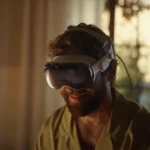Highlights from CES: Talking heads, airlifts and checkpoints for pets
Whether dreaming of an artificial friend available around the clock, lifting off from traffic jams or doing without your cat’s dead bird “gifts,” CES inventors have no shortage of imagination. Here are a few highlights from the Consumer Electronics Show, the world’s biggest tech and consumer electronics trade fair, which runs in Las Vegas until Friday.
Talking Heads: Wehead and ChatGPT
“I’m designed to be a supportive and nonjudgmental presence in your life,” assured Wehead, a sort of computer creature made of a set of screens, mounted on a robotic head, projecting a human face and that uses Artificial Intelligence.
The US startup of the same name developed this strange object that can be placed on your desk like a paperweight or small sculpture and engage in human-like chit chat.
“Sometimes you just need somebody to talk to and create your own solutions,” said Wehead founder Ilya Sedoshkin. “You can do that with ChatGPT, but you will not have this natural feeling that somebody’s listening to you,” said Sedoshkin.
Wehead runs on ChatGPT, has real-time internet access and more memory than the famous OpenAI chatbot that produces text, sound or images from a simple query in everyday language.
Enthusiasts can adopt a talking head on a subscription basis, for $200 a month. “Did it feel real? No,” said Alan Pierce, a retired professor attending the Tech show, calling it a cleverly designed “talking head.”
Airlift Innovation: S-A2 eVTOL
A cross between a helicopter and a plane, the electric powered S-A2 is pitted to become the Transport of choice for cities paralyzed by traffic jams. Its real name is eVTOL—electric vertical take-off and landing vehicle. It has a pilot and up to four passengers on board.
“It’s urban aerial mobility,” Jaiwon Shin, head of Supernal, a subsidiary of South Korea’s Hyundai Group, told AFP. “The biggest market is the United States—cities like Las Vegas or Los Angeles.”
An hour-long car journey due to traffic jams can be replaced by a flight of just 10 minutes, departing from so called vertiports that would be dotted around a city.
Jaiwon hopes to launch in 2028, but the regulatory hurdles are considerable. “It has never been done before in aviation… It’s really a revolution and the battery is a technological challenge,” he said.
Keep Your Pets Safe: Pawport and Flappie
Installing a door hatch to let cats and dogs roam freely in and out of the house also leaves the Home open to wildlife. For Martin Diamond, a resident of the desert state of Arizona, unwelcome visitors could include coyotes, venomous snakes and raccoons.
Not eager to meet one of these in his living room, Diamond invented Pawport, a hermetically sealed door that opens with a badge worn by the pet. Pawport can be installed on an existing hatch, is available in several sizes and finishes, and can be powered by a rechargeable battery, a solar panel, or connected to the electrical grid.
Swiss twins Oliver and Denis Widler turned to other unpleasant surprises: the “gifts”—birds and rodents in general—that some cats proudly bring back to their owners. With their Flappie access door, AI cameras keep an eye on things and block access if the feline’s mouth isn’t empty.
The AI also will spot snakes and fish, the startup claims, with an efficiency of over 90 percent. And the door opens only to those with a microchip. The device can be connected to an app so that owners can track their pet’s comings and goings, complete with images.
With these exciting innovations showcased at CES, the possibilities for technology and consumer electronics continue to expand, demonstrating that imagination knows no bounds.
Source: phys








No Comments